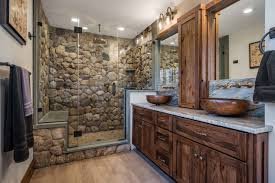Natural stone tiles are a luxurious, timeless option that can instantly elevate the look of any bathroom. Whether you’re dreaming of a sleek marble shower, rustic travertine floors, or elegant slate walls, natural stone adds a unique and organic beauty that’s hard to replicate with other materials. However, as stunning as natural stone is, it also comes with specific challenges, especially when used in moisture-prone environments like bathrooms.
In this blog, we’ll explore the pros and cons of using natural stone tiles in a bathroom setting. From the undeniable beauty they bring to the practical considerations of maintenance and installation, we’ll help you determine whether natural stone is the right choice for your bathroom renovation.
The Pros of Using Natural Stone in a Bathroom
1. Timeless Beauty and Aesthetic Appeal
The biggest reason homeowners are drawn to natural stone is its unmatched beauty. Each stone is a product of nature, so every tile is unique, with its own variation in color, texture, and veining. This individuality adds character and depth to any bathroom design, making it feel more sophisticated and one-of-a-kind.
- Variety of Stones: From the refined elegance of marble to the earthy warmth of travertine and the rugged texture of slate, natural stone offers a wide range of styles to suit different tastes and design preferences.
- Natural Variation: Unlike man-made tiles, no two natural stone tiles are exactly alike. The variation in patterns and tones adds a dynamic, organic element to your space, making each installation a work of art.
- Luxury and Status: There’s a reason natural stone is often associated with high-end design. Its timeless appeal gives bathrooms a luxurious feel, whether you opt for polished marble floors or a natural stone shower surround.
2. Durability and Longevity
Natural stone, when properly maintained, can last a lifetime, making it a sound investment for homeowners who want a durable and long-lasting material in their bathrooms.
- Durable Underfoot: Stones like granite and slate are incredibly hard and resistant to wear, making them excellent choices for bathroom floors that see heavy foot traffic.
- Withstands High Temperatures: Natural stone is heat-resistant, which makes it ideal for use with underfloor heating systems or near radiant heating sources. This makes it a great option for creating spa-like, cozy bathroom environments.
- Aging Gracefully: Over time, natural stone tends to develop a patina, a natural sheen that enhances its character and beauty. Many homeowners love the way stone improves with age, gaining more depth and personality as the years go by.
3. Boosts Property Value
A bathroom with natural stone tiles can significantly increase the value of your home. Stone surfaces are often seen as a premium feature that appeals to potential buyers and can help set your property apart in a competitive market.
- Timeless Appeal: Because of its classic look, natural stone rarely goes out of style. This means that even as design trends come and go, a well-installed stone bathroom will continue to look elegant and relevant.
- Perceived Value: Natural stone often evokes a sense of luxury and high quality, which can translate into higher resale value for your home. Potential buyers are often willing to pay more for premium materials like marble, limestone, or granite.
The Cons of Using Natural Stone in a Bathroom
While natural stone offers undeniable advantages, it’s important to be aware of the challenges it presents—especially in a high-moisture environment like a bathroom. Let’s take a look at some of the drawbacks of using natural stone tiles in a bathroom setting.
1. High Maintenance Requirements
One of the biggest downsides to natural stone is its need for regular maintenance. Unlike ceramic or porcelain tiles, natural stone is porous, which means it can absorb water, oils, and stains if not properly sealed and maintained.
- Sealing: To protect stone from moisture and staining, it must be sealed regularly. Most natural stone needs to be sealed upon installation and then re-sealed periodically, typically every 6-12 months depending on the stone type and bathroom usage.
- Cleaning Products: You can’t use just any cleaning products on natural stone. Harsh chemicals, particularly acidic cleaners like vinegar or bleach, can etch or damage the stone’s surface. You’ll need to invest in pH-neutral stone cleaners and be diligent about proper cleaning routines.
- Stain Vulnerability: Certain stones, like marble and limestone, are particularly prone to staining, especially from soap, shampoo, and even hard water. Regular sealing helps, but you’ll still need to be cautious about what comes into contact with the surface.
2. Moisture and Water Absorption Issues
Bathrooms are naturally damp environments, which can be problematic for certain types of natural stone. Some stones are more absorbent than others, and if water penetrates the stone, it can lead to staining, discoloration, or even mold and mildew growth beneath the surface.
- Porous Stones: Marble, limestone, and travertine are more porous than other stones, meaning they are more susceptible to moisture-related issues like water stains or mold. In a bathroom, where moisture is constantly present, this can lead to long-term problems if not addressed properly.
- Slip Hazards: Some natural stones, especially when polished, can become quite slippery when wet. This is particularly important to consider for bathroom floors, where water is often present. Non-slip finishes or textured stones like slate may be better suited for bathroom floors to reduce the risk of slipping.
3. Cost Considerations
Natural stone is often more expensive than other tile options, both in terms of the material itself and the installation process. If you’re on a budget, it’s important to consider whether the added cost is worth it for your particular bathroom renovation.
- Material Costs: Natural stone tiles tend to cost more per square foot compared to ceramic or porcelain tiles. High-end stones like marble or granite can be significantly more expensive, especially if they are rare or come from a specific quarry.
- Installation Costs: Installing natural stone tiles requires specialized knowledge and tools. Because natural stone can be more difficult to cut and install properly (due to its weight and fragility), the cost of labor is often higher than with other types of tile. Additionally, expert installation is critical to avoid issues like uneven tiles or improper sealing.
4. Potential for Damage
While natural stone is durable, it’s not indestructible. Certain stones, particularly softer options like marble and limestone, can be prone to chipping, scratching, or etching over time.
- Soft Stones: Marble and limestone, though stunning, are more prone to surface damage than harder stones like granite or slate. Over time, everyday use (particularly in bathrooms) can lead to wear and tear, including scratches from dropped objects or etching from exposure to acidic substances.
- Repair Challenges: Repairing damaged natural stone can be more complicated and costly than with other tile materials. Chips or cracks often require professional intervention, and matching the color and pattern of the stone can sometimes be difficult if the original tiles are no longer available.
Important Considerations Before Installing Natural Stone in a Bathroom
While the pros and cons of natural stone provide a helpful overview, here are a few key considerations to help you make the right choice for your bathroom:
1. Stone Type and Placement
Different types of natural stone are better suited to certain areas of the bathroom than others. For example, while polished marble might look stunning on a vanity countertop, it may not be the best choice for a high-traffic shower floor, where water and soap could lead to staining and slippage. Consider the specific characteristics of each stone when deciding where to use it.
- Marble: A luxurious choice for countertops and walls, but be cautious of using it in high-moisture areas without proper sealing.
- Travertine: Ideal for floors, thanks to its textured finish, but requires regular maintenance due to its porosity.
- Granite: Highly durable and stain-resistant, making it a good option for countertops or even shower surrounds.
- Slate: Offers a naturally slip-resistant surface, perfect for floors, but can be difficult to cut and install.
2. Regular Maintenance Commitment
Natural stone can be a wonderful investment, but only if you’re prepared to keep up with regular maintenance. This means committing to periodic sealing, gentle cleaning, and occasional inspections to address any damage or wear.
- Sealing: Make sure to follow a sealing schedule appropriate to your specific stone and bathroom use.
- Careful Cleaning: Avoid using abrasive or acidic cleaners, and stick to pH-neutral products specifically designed for natural stone care.
3. Climate and Environmental Factors
In areas with high humidity or fluctuating temperatures, natural stone can expand and contract slightly. This can cause grout lines to crack or tiles to shift over time, so it’s important to choose stones that can withstand these conditions, or to ensure proper installation practices are followed to mitigate these effects.
Conclusion: Is Natural Stone the Right Choice for Your Bathroom?
Natural stone tiles offer an undeniable allure that’s hard to match with other materials. Their timeless beauty, variety of styles, and long-lasting durability make them an attractive choice for bathrooms, but they do come with challenges—particularly in terms of maintenance, moisture resistance, and installation costs.
If you’re willing to invest in proper care and choose the right stone for your bathroom’s specific needs, natural stone can add incredible value and elegance to your space. However, it’s important to weigh the long-term maintenance and installation complexities before making a decision. Ultimately, a well-installed natural stone bathroom can be a beautiful, lasting addition to your home—one that brings both luxury and functionality to your daily routine.


